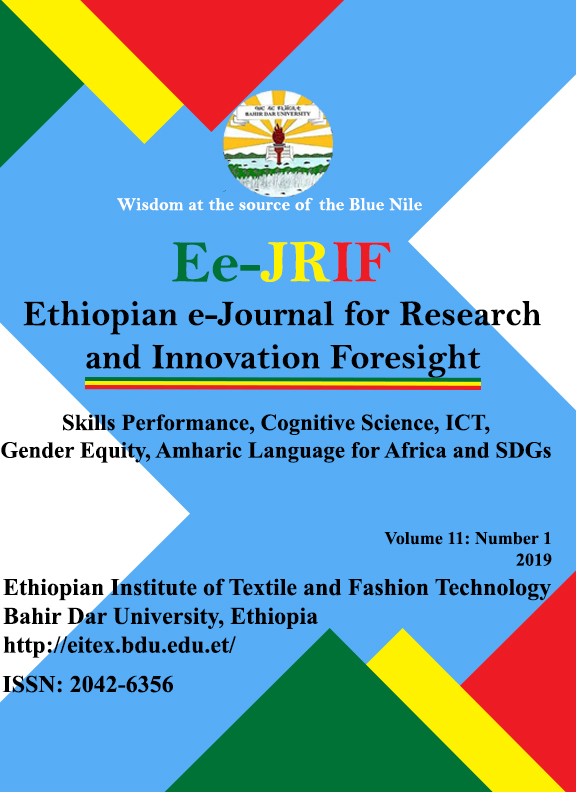PHONOTACTIC SYLLABIFICATION SYSTEMS OF ENGLISH AND AMHARIC LANGUAGES AND A CASE FOR LANGUAGE OF AFRICAN UNION FOR AFRICA
Abstract
Phonotactics sets rules for proficiency in language usage, especially in English Language, (a foreign language) and Amharic an African Language. This study sets out to analyse the phonotactic presence and similarities in their syllabic systems, for possibility of Amharic emerging as a language of African Union to replace English language during summits and international conferences, albeit as a starter. Many linguists, especially the Nigerian nobel laureate Prof. Wole Soyinka have suggested other African languages like Swahili. This is an effort to prevent our indigenous knowledge from going into extinction. The justification for suggesting Amharic here is the natural and originality of the Geez feedel or script form where Amharic alphabetic system was developed. It is indigenous to Africa, with its origin in Axum, Ethiopia. Amharic shares some linguistic features of sounds like vowel sonority with English language and it is easy for anyone with proficiency in English to understand the Amharic sounds articulation and their acostic allophonic references. The exploration of this unfamiliar terrain is worthy of consideration as a policy innovation for cultural and linguistic emancipation. The objective therefore is to contribute to the current trends in innovation in the area of language development in African continents. It is one of our own indigenous languages, widely spoken and its origin is African. This may be a starting point in solving the problem of colonial albatross that slows down development in Africa, where colonial languages are used for instructions in schools and in research. The researchers used scripts developed online; Wikipedia, books, personal contacts and information from the indigenous people of Ethiopia. These were selected through purposive research design. Syllabification Theory, Chomsky’s Theory of transfer and Contrastive Analysis were used for the study. Findings revealed that the similarity of sounds of English and Amharic makes it easy to understand the syllabification system of Amharic conforms with the composite structure of English and most world languages that combine consonants and vowels sounds. The tone and rhythmic patterns of the suprasegmental features add greater value to its musical cadences, especially when children speak during Amharic language lessons. It is therefore recommended that since Amharic language, based on our findings is suitable as a possible language of African Union. Language policy makers in Africa sub regions can organize a pan-African conference to debate the possibility and implementation. By this, it will continue to spread from Ethiopia to the rest of African nations and its sub-regions as an African linguistic identity.References
Albert. C Baych (1951), A history of the English language (2n edit), England Routledge and Kegan Paul ltd, Henleg on Thomas, Oxon RG9, EN.
Bender, et al (1976), The Ethiopian writing system in Bender et al language in Ethiopia, London, oxford university pp 120-128.
Blevin (1995) Omniglot online encyclopedia. https://www.omniglot.com
Chomsky and Haller 1968, Crimsuun 1989, Gussman 1991 Wells 1995 in zoesoft (onhu Engclopaedia.
Chrystal, D (2001) The Cambridge Encyclopedia of the English language Cambridge University press.
Collins (2006) Easy learning French conversation Harper Collins publishers, Great Britain, Glasgow.
Fasanmi O. T. (2018) State of the Art Technology, language laboratory phonotactics and higher education: English language learning and laboratory phonotactics. In journal of language and literary studies, English Department, Mountain Top University, Lagos, Nigeria. Vol 1 (2).
Freederic and Wessees (1993) Jusczyet et al 1994 Omniglot online Encyclopedia.
Friederici and Wessels 1993, Jusczyk et al (1993, 1994) Phonotactics, Science Direct, Topics.online, Encyclopedia.
Hirut Woldermarism (2008) in Omniglot online encyclopedia.
Hirut, W (2007) Language matters studies in the language of Africa. Vol 38, 2007-issue 2 pp210-235 online encyclopedia.
Omniglot online Encyclopedia hay (2009) in Encyclopedia.
Omniglot The online Encyclopedia of writing systems and languages https://www.omnislot.com.
Phillipson and Skutnabbkangs (1995) in Omniglot online Encyclopedia.
Roach, P (2009) English Phonetics and Phonology (A Pratical course) 4th edition, United Kingdom, Cambridge university press.
Rockeys (1993) Phonetics lexicon and online pronunciation dictionary beeps.
Thomas Bloor and Wondwosen Tamrat (1995) issues in Ethiopian language policy and education in journal of multilingual and multicultural development vol17, 1995, issues published online. www. Tandfonline.com>doi>abs.
Zoe Toft O. Phonetics and phonology of some syllabic consonants in Southern British English, school of oriental and African studies, London, University of London.
Copyright (c) 2020 FASANMI OLUFUNSO TOSIN, FAMUYIWA AYODELE TOLULOPE O.

This work is licensed under a Creative Commons Attribution-NonCommercial 4.0 International License.

